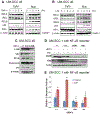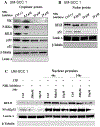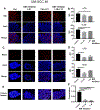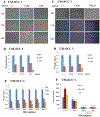Lymphotoxin-β receptor-NIK signaling induces alternative RELB/NF-κB2 activation to promote metastatic gene expression and cell migration in head and neck cancer
- PMID: 30488488
- PMCID: PMC7066987
- DOI: 10.1002/mc.22938
Lymphotoxin-β receptor-NIK signaling induces alternative RELB/NF-κB2 activation to promote metastatic gene expression and cell migration in head and neck cancer
Abstract
Head and neck squamous cell carcinomas (HNSCC) preferentially spread to regional cervical tissues and lymph nodes. Here, we hypothesized that lymphotoxin-β (LTβ), receptor LTβR, and NF-κB-inducing kinase (NIK), promote the aberrant activation of alternative NF-κB2/RELB pathway and genes, that enhance migration and invasion of HNSCC. Genomic and expression alterations of the alternative NF-kB pathway were examined in 279 HNSCC tumors from The Cancer Genome Atlas (TCGA) and a panel of HNSCC lines. LTβR is amplified or overexpressed in HNSCC of the larynx or oral cavity, while LTβ, NIK, and RELB are overexpressed in cancers arising within lymphoid oropharyngeal and tonsillar sites. Similarly, subsets of HNSCC lines displayed overexpression of LTβR, NIK, and RELB proteins. Recombinant LTβ, and siRNA depletion of endogenous LTβR and NIK, modulated expression of LTβR, NIK, and nuclear translocation of NF-κB2(p52)/RELB as well as functional NF-κB promoter reporter activity. Treatment with a NIK inhibitor (1,3[2H,4H]-Iso-Quinoline Dione) reduced the protein expression of NIK and NF-κB2(p52)/RELB, and blocked LTβ induced nuclear translocation of RELB. NIK and RELB siRNA knockdown or NIK inhibitor slowed HNSCC migration or invation in vitro. LTβ-induces expression of migration and metastasis related genes, including hepatocyte growth/scatter factor receptor MET. Knockdown of NIK or MET similarly inhibited the migration of HNSCC cell lines. This may help explain why HNSCC preferentially migrate to local lymph nodes, where LTβ is expressed. Our findings show that LTβ/LTβR promotes activation of the alternative NIK-NF-κB2/RELB pathway to enhance MET-mediated cell migration in HNSCC, which could be potential therapeutic targets in HNSCC.
Keywords: HNSCC; LTβ/LTβ receptor; NIK; RELB/NF-κB2; migration.
© 2018 Wiley Periodicals, Inc.
Conflict of interest statement
Figures






Similar articles
-
Lymphotoxin beta-activated LTBR/NIK/RELB axis drives proliferation in cholangiocarcinoma.Liver Int. 2024 Nov;44(11):2950-2963. doi: 10.1111/liv.16069. Epub 2024 Aug 20. Liver Int. 2024. PMID: 39164890
-
Etiology-independent activation of the LTβ-LTβR-RELB axis drives aggressiveness and predicts poor prognosis in HCC.Hepatology. 2024 Aug 1;80(2):278-294. doi: 10.1097/HEP.0000000000000657. Epub 2023 Nov 2. Hepatology. 2024. PMID: 37916976
-
Expression Of Intracellular Components of the NF-κB Alternative Pathway (NF-κB2, RelB, NIK and Bcl3) is Associated With Clinical Outcome of NSCLC Patients.Sci Rep. 2019 Oct 4;9(1):14299. doi: 10.1038/s41598-019-50528-y. Sci Rep. 2019. PMID: 31586084 Free PMC article.
-
Biology and signal transduction pathways of the Lymphotoxin-αβ/LTβR system.Cytokine Growth Factor Rev. 2011 Oct-Dec;22(5-6):301-10. doi: 10.1016/j.cytogfr.2011.11.007. Cytokine Growth Factor Rev. 2011. PMID: 22152226 Review.
-
The noncanonical NF-κB pathway.Immunol Rev. 2012 Mar;246(1):125-40. doi: 10.1111/j.1600-065X.2011.01088.x. Immunol Rev. 2012. PMID: 22435551 Free PMC article. Review.
Cited by
-
Dual Role of TNF and LTα in Carcinogenesis as Implicated by Studies in Mice.Cancers (Basel). 2021 Apr 8;13(8):1775. doi: 10.3390/cancers13081775. Cancers (Basel). 2021. PMID: 33917839 Free PMC article. Review.
-
LUBAC enables tumor-promoting LTβ receptor signaling by activating canonical NF-κB.Cell Death Differ. 2024 Oct;31(10):1267-1284. doi: 10.1038/s41418-024-01355-w. Epub 2024 Aug 30. Cell Death Differ. 2024. PMID: 39215104 Free PMC article.
-
Lymphotoxin-β promotes breast cancer bone metastasis colonization and osteolytic outgrowth.Nat Cell Biol. 2024 Sep;26(9):1597-1612. doi: 10.1038/s41556-024-01478-9. Epub 2024 Aug 15. Nat Cell Biol. 2024. PMID: 39147874
-
Tumor-specific T cells support chemokine-driven spatial organization of intratumoral immune microaggregates needed for long survival.J Immunother Cancer. 2022 Feb;10(2):e004346. doi: 10.1136/jitc-2021-004346. J Immunother Cancer. 2022. PMID: 35217577 Free PMC article.
-
TNFR2 Signaling Enhances ILC2 Survival, Function, and Induction of Airway Hyperreactivity.Cell Rep. 2019 Dec 24;29(13):4509-4524.e5. doi: 10.1016/j.celrep.2019.11.102. Cell Rep. 2019. PMID: 31875557 Free PMC article.
References
-
- Siegel RL, Miller KD, Jemal A. Cancer statistics, 2016. CA Cancer J Clin. 2016. Jan-Feb;66(1):7–30. PubMed PMID: 26742998. - PubMed
-
- Leemans CR, Braakhuis BJ, Brakenhoff RH. The molecular biology of head and neck cancer. Nat Rev Cancer. 2011. January;11(1):9–22. PubMed PMID: 21160525. - PubMed
-
- Shang Xie HX, Shan Xiaofeng, Liu Baozhong, Wang Kan, Cai* Zhigang. Clinicopathological and prognostic significance of survivin expression in patients with oral squamous cell carcinoma: evidence from a meta-analysis. PLOS One. 2015; 10(2):0116517. PubMed PMID: 25710884. Pubmed Central PMCID: PMC4339736. - PMC - PubMed
-
- Bauer J NS, Reisinger F, Zoller J, Yuan D,Heikenwalder M. Lymphotoxin, NF-kB, and cancer: the dark side of cytokines. Dig Dis. 2012;30(5):453–68. PubMed PMID: 23108301. - PubMed
Publication types
MeSH terms
Substances
Grants and funding
LinkOut - more resources
Full Text Sources
Medical
Molecular Biology Databases
Miscellaneous

